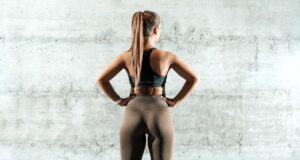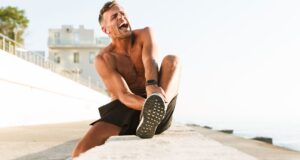That really burns: Thanks to their intensity, squats ensure a trained buttocks in no time. But for this, the leg, gluteal and trunk muscles also have to work properly. We promise you that it’s guaranteed to be worth it.
Because with no other exercise can you make your thighs and buttocks crisp as quickly as with squats – if they are performed correctly. We’ll show you why that is and how to do it right.
What is a squat?
No big gymnastics exercise: In weight training, the squat is a basic exercise, it is one of the most popular exercises for legs and buttocks. The name says it all: Stand down, bend your knees and go down very low with your back straight, then up again.
In English, this intense exercise is called squat and you are guaranteed to have done it before. And clearly felt the burning sensation in your thighs and bottom, right?
The squat is a bodyweight exercise, i.e. a fitness exercise that only uses your own body weight to help – and of course also uses gravity. Because when you sit deep, you have to keep your weight stable and bring it up and down in a controlled manner.
How do you do a squat?
Another advantage of the squat: it is not complicated to perform. You can do the simple exercise without any devices, equipment or gym.
- Put your legs shoulder-width apart, the toes should point outwards rather than inwards. Your kneecaps are pointing in the same direction as your big toes.
- Tense your abdominal muscles – a strong core supports your back!
- Put your bottom back as you go deeper. The weight shifts to the heels. The heels always stay on the ground. Your upper body stays upright, but you can also lean it forward a little if that’s easier for you. You can bring your arms up when you go down.
- Come back up to the starting position.
What do I have to consider when performing squats?
When done correctly, the squat ensures a flexible lower body, strong legs and a firm bottom. If done incorrectly, the squat can also put a lot of strain on your ankles, knees, and lower back. Therefore, pay attention to the following tips for your next training session:
- Don’t just try to bend your knees, but rather to sit back specifically. So you bring your buttocks back as you go further down. This puts your weight on your heels and not on your toes.
- Only go down as far as you can keep your knees turned outward. Try actively to push your knees outward. that way you put the least strain on your knees. The kneecap should always point in the same direction as the big toe.
- Your back should neither be curved (i.e. round) nor fall heavily into the hollow back. The back should be slightly arched, but only strong enough that you don’t damage your lower back. To do this, open your chest and relax your shoulders. Also, activate your pelvic floor and try to support your lower back with active core muscles.
- Under no circumstances should your heels lift off the ground, they should always be in contact with the ground. If this is difficult for you, you can, for example, put a blanket or a block under your heels. This is how you guarantee a safe stand.

Which muscles are used in squats?
Squats are real all-rounders, no wonder almost every strength athlete does them! When you incorporate squats into your training, you train the muscles of your thighs, buttocks, back and stomach.
The dynamic exercise also promotes your cardiovascular system and your coordination. Happiness hormones and sore muscles are also included.
Do Squats Help You Lose Weight?
Indeed they do. Because with every squat you strain some of the largest muscle groups in the whole body, for example the gluteus maximus, the thigh muscle (quadriceps femoris) and the hamstrings (biceps femoris).
As you probably know, big muscles burn a lot of calories. So every set of squats not only trains legs and buttocks, but also generates a lot of revenue on the fat burning account.
How many reps should i do?
It all depends on how practiced you are. At the beginning 15-20 repetitions are optimal. You can steadily increase the number of repetitions or the intensity.
How about, for example, squats with weights? We’ll show you the best variations for squats below.
Do I need squat equipment?
In principle, you don’t need any equipment for squats, because they are part of the self-weight exercises. This means that when doing squats you only work with your own body weight as training weight. You benefit from gravity as an aggravating factor.
As mentioned, if you want to go a step further, you can also do your squats with weighted vests, barbells, dumbbells or kettlebells.
What are the best squat variations?
The standard version is great – but of course we’ll also show you how to take your squats to the next level. Here are the best and most intense squat variations:
- Goblet Squat: In the goblet squat, you use a kettlebell to help you. Hold the dumbbell like a goblet in front of your chest with both hands.
- Pause Squat: The name is given to this squat program. With this variation of the squat, you take a short break at the lowest point, where it really burns.
- Overhead Squat: You need a barbell for this squat variation. First you bring this safely and stably over your head. With the barbell over your head, you then perform your squat as normal.
- Jump Squat: This variant can be best described as ” squat -stretch-jump”. When you get to the lowest point of your squat at the bottom, don’t slowly go back up, but jump and do a stretch jump. The arms are brought over the head.
With these tips and variations, you are now ready to include squats in your training plan. It’s best to start your squat workout today and get your thighs really burning. It is worth it!




